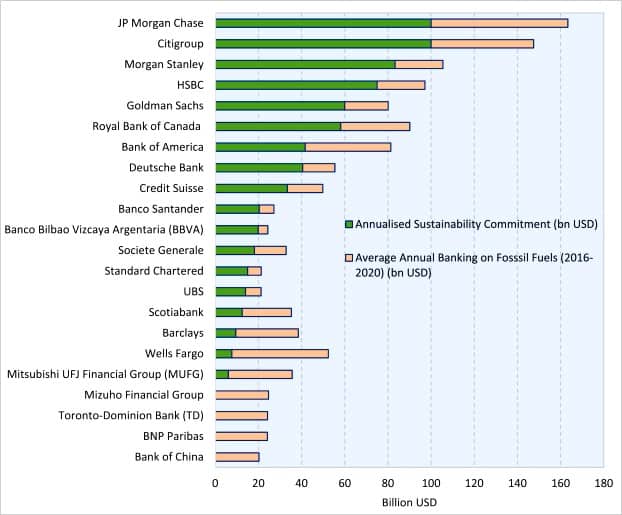The banking industry stands out from other sectors in its capacity to help firms transition to a low-carbon economy through the major banks’ $5.5 trillion climate commitment to finance and invest in sustainable projects.
In a report by the International Energy Agency, investments in new coal mines, oil and gas wells had to end immediately for the world to meet its Paris climate goal of limiting warming to 1.5 degrees Celsius.
Yet, fossil fuel financing from the world’s biggest banks amounted to $4.6 trillion U.S. dollars in the 6 years since the 2015 Paris agreement. $742 billion was for fossil fuel financing in 2021 alone.
At the COP27 summit, negotiators estimated that up to $6 trillion has to be invested each year in renewables and decarbonization until 2030 to reach net zero emissions by 2050.
Two major UK banks, Barclays and HSBC, pledged a total of US$2 trillion, with $1 trillion each, by 2030. While another two large US banks, JPMorgan Chase ($2.5 trillion) and Citigroup ($1 trillion), have committed a total of $3.5 trillion last year to sustainable initiatives by the same decade.
Banking on Climate & Sustainable Financing
Banks are not just providing capital to firms that innovate climate change solutions. Other activities include:
- advising clients on the transition to net zero such as mergers and acquisitions,
- asset disposal, and
- financing of green projects.
A UK major bank Barclays revealed that it aims to allot $1 trillion of its funds by the end of 2030 for sustainable financing. It will be primarily to support firms that transition to a low-carbon economy. It will also be to ramp up its debt and equity capital markets to meet its climate goals.
Barclays said that it will focus on providing advisory services and deliver financing to firms to help expand their green technologies.
- The $1 trillion climate pledge will involve green mortgages, sustainable financing structures, and financing for renewable energy firms.
Part of its climate commitment, the major bank is also ramping up its equity capital investments after seeing success in this space. To date, it has invested £84 million in scaling up startups that innovate renewable energy storage solutions.
Its new investment will center on prominent decarbonization technologies such as hydrogen and carbon capture. These technologies are critical to helping carbon-intensive sectors transition to lower carbon use. Common areas include energy and power, real estate, and transportation.
- This new climate commitment marks a big increase from the bank’s goal to provide sustainable investments from £175m by 2025 to £500m by 2027. The $1 trillion pledge starts from 2023.
Barclays is not the only financier that’s ramping up its funding to help the world decarbonize.
Other major banks are also updating and increasing their climate commitment to stir up the transition. But some of them are struggling to weather big criticisms that most are still financing new fossil fuel projects. HSBC is one example.
HSBC Climate Policy Update
Europe’s largest bank HSBC updated its climate policy saying it will no longer offer new lending or capital market financing for new oil and gas fields or related projects.
The banking giant has also said it plans to provide up to $1 trillion in sustainable financing and investments by 2030. A responsible investment lobby group welcomed HSBC’s move, remarking:
“HSBC’s announcement sends a strong signal to fossil fuel giants and governments that banks’ appetite for financing new oil and gas fields is diminishing. It sets a new minimum level of ambition for all banks committed to net zero. We urge major banks like Barclays and BNP Paribas to follow suit.”
However, HSBC will still provide financing and advisory services to existing fossil fuel projects. But that should be “in line with current and future declining global oil and gas demand”.
And while it will do the same to energy sector clients, it will assess the firms’ plans in relation to clean energy transition.
Last October, Britain’s largest domestic bank Lloyds Bank also announced the same intention. It will no longer provide direct financing to fossil fuel projects as part of its new climate policy.
More Climate Commitment from US Major Banks
U.S. major banks are also catching up to the trend. JPMorgan Chase & Co. and Citigroup, in particular, are two examples. The chart shows their sustainable finance budget from 2016 to 2020, along with other large financiers.

JPMorgan Chase announced last year that it will spend $2.5 trillion over 10 years, until 2030. The bank will use its finances for “long-term solutions that address climate change and contribute to sustainable development.”
Likewise, Citi also committed $1 trillion for sustainable finance by 2030. That is an extension of its environmental finance targets from $250 billion by 2025 to $500 billion by 2030. The fund will be for renewable energy and clean technology, green buildings, and sustainable agriculture and land use.
While they have different amounts in climate commitment, all major banks share the same goal – speed up the transition to a sustainable, low carbon economy.

